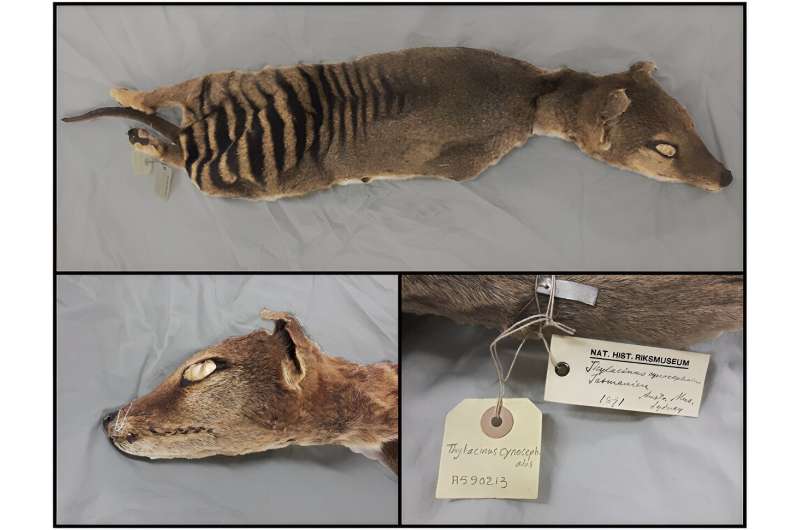This article has been reviewed according to Science X's editorial process and policies. Editors have highlighted the following attributes while ensuring the content's credibility:
fact-checked
peer-reviewed publication
trusted source
proofread
RNA has been recovered from an extinct species for the first time

A new study shows the isolation and sequencing of more than a century-old RNA molecules from a Tasmanian tiger specimen preserved at room temperature in a museum collection. This resulted in the reconstruction of skin and skeletal muscle transcriptomes from an extinct species for the first time.
The researchers note that their findings have relevant implications for international efforts to resurrect extinct species, including both the Tasmanian tiger and the wooly mammoth, as well as for studying pandemic RNA viruses.
The Tasmanian tiger, also known as the thylacine, was a remarkable apex carnivorous marsupial that was once distributed all across the Australian continent and the island of Tasmania. This extraordinary species found its final demise after European colonization, when it was declared as an agricultural pest and a bounty of £1 per each full-grown animal killed was set by 1888. The last known living Tasmanian tiger died in captivity in 1936 at the Beaumaris Zoo in Hobart, Tasmania.
Recent efforts in de-extinction have focused on the Tasmanian tiger, as its natural habitat in Tasmania is still mostly preserved, and its reintroduction could help recovering past ecosystem equilibriums lost after its final disappearance. However, reconstructing a functional living Tasmanian tiger not only requires a comprehensive knowledge of its genome (DNA) but also of tissue-specific gene expression dynamics and how gene regulation worked, which are only attainable by studying its transcriptome (RNA).
"Resurrecting the Tasmanian tiger or the wooly mammoth is not a trivial task, and will require a deep knowledge of both the genome and transcriptome regulation of such renowned species, something that only now is starting to be revealed," says Emilio Mármol, the lead author of a study recently published in the Genome Research journal by researchers at SciLifeLab in collaboration with the Centre for Paleogenetics, a joint venture between the Swedish Museum of Natural History and Stockholm University.
RNA molecules recovered from the Tasmanian tiger
The researchers behind this study have sequenced, for the first time, the transcriptome of the skin and skeletal muscle tissues from a 130-year-old desiccated Tasmanian tiger specimen preserved at room temperature in the Swedish Museum of Natural History in Stockholm. This led to the identification of tissue-specific gene expression signatures that resemble those from living extant marsupial and placental mammals.
The recovered transcriptomes were of such good quality that it was possible to identify muscle- and skin-specific protein coding RNAs, and led to the annotation of missing ribosomal RNA and microRNA genes, the later following MirGeneDB recommendations.
"This is the first time that we have had a glimpse into the existence of thylacine-specific regulatory genes, such as microRNAs, that got extinct more than one century ago," says Marc R. Friedländer, Associate Professor at the Department of Molecular Biosciences, The Wenner-Gren Institute at Stockholm University and SciLifeLab.
This pioneering study opens up new exciting opportunities and implications for exploring the vast collections of specimens and tissues stored at museums across the globe, where RNA molecules might await to be uncovered and sequenced.
"In the future, we may be able to recover RNA not only from extinct animals, but also RNA virus genomes such as SARS-CoV2 and their evolutionary precursors from the skins of bats and other host organisms held in museum collections," says Love Dalén, Professor of evolutionary genomics at Stockholm University and the Centre for Paleogenetics.
The authors of the study say they are excited for future holistic research developments integrating both genomics and transcriptomics towards a new era in paleogenetics beyond DNA.
More information: Emilio Marmol-Sanchez et al, Historical RNA expression profiles from the extinct Tasmanian tiger, Genome Research (2023). DOI: 10.1101/gr.277663.123
Journal information: Genome Research
Provided by Stockholm University





















